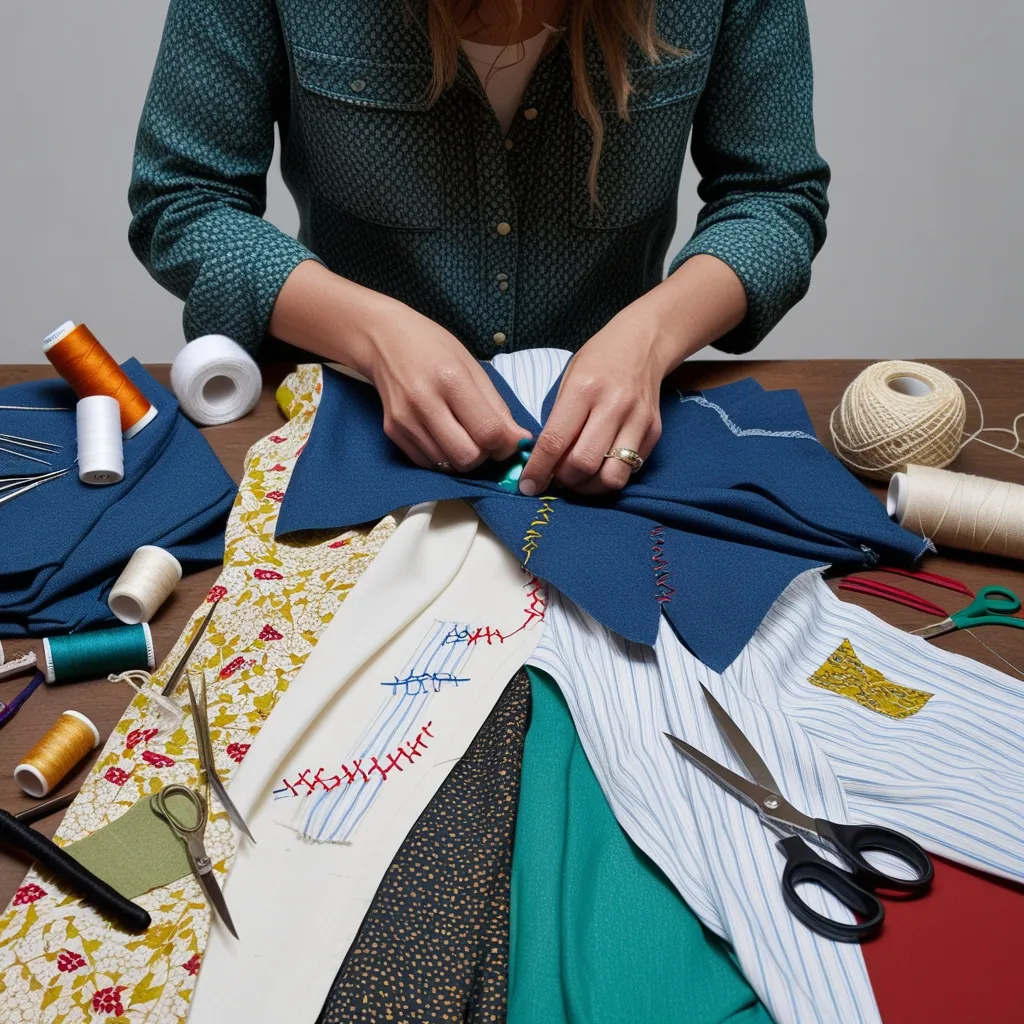In today’s whirlwind of trends and fast fashion, knowing how to sew can be a real game-changer. Not only does it help keep your favorite pieces around for longer, but it’s also a step towards a more sustainable lifestyle. We’ll walk you through mending your clothes so you can skip the store and save both money and the planet.
The Case for Mending Clothes
Fixing your clothes isn’t just a practical skill; it’s a quiet rebellion against the wasteful fashion industry. The longer you can keep a piece of clothing in your rotation, the less you lean on fast fashion, known for its pollution-heavy practices. Plus, sewing repairs save you cash and fosters a circular fashion economy, which is just a fancy way of saying “less waste, more use.”
Gear Up: Essentials for Mending
Before you jump into sewing, it’s essential to gather the basics. Think of it like setting up a toolbox, but for fabrics. You’ll need standard needles (often called “sharps”), thread matching your garments in color and weight, sharp scissors, and something to mark your fabric like tailor’s chalk or a marker. An embroidery hoop can make life a lot easier by holding your fabric taut.
Pinpointing the Problem
Marking the area you’re going to fix is crucial. Tailor’s chalk or a marker gives you flexibility and is easy to see, but even a straight pin with a ball head can do the trick. Precision is key here, so maybe grab a ruler for accuracy. Think of this step as setting the stage before the main act.
Basic Hand Sewing Skills
Understanding a few basic stitches can make a world of difference. Let’s start with some must-know techniques:
Sewing a Button
Who hasn’t had a button pop off? Thread your needle and tie a knot at the end. Position the button where it belongs and push the needle through the button holes and fabric. To secure it, wrap the thread around the button a few times and tie a final knot. Voilà, the button is back in action.
Fixing a Hem
Got a hem that’s come loose? The blanket stitch is your friend here. Start from one end of the loose hem, grab a couple of fabric threads, and pull through. Move the needle about a quarter inch to the left and down, then stitch through the top layer. Keep going until you’ve fixed the whole hem and tie it up with a knot.
Patching Up Little Holes
Tiny holes are quick to mend. Thread your needle, tie a knot, and sew over the hole, stretching the fabric as you go to cover it completely. It usually takes one or two stitches and you’re done in minutes.
Tackling Pulled Threads
A pulled thread can make your clothes look worn out. Fixing it is quite simple. Use a needle to pull the snagged thread to the fabric’s backside. Stretch the fabric along the affected thread to even it out and make a knot to secure it, if necessary.
Seams Ripped? No Worries
Ripped seams are another easy fix. Depending on the type of seam, you might need either a simple backstitch or a ladder stitch. Backstitches sew in reverse along the seam with small stitches. For ladder stitches, weave your thread in and out of both sides of the seam, then pull tight to close the gap. Stitching back and forth like this reinforces the seam and gets you back on track.
Embrace Upcycling and Visible Mending
Sometimes a garment is too far gone to be fixed in its original form. This is where upcycling shines. Old jeans can become shorts; stained shirts can take on new life with some fabric paint. Visible mending is also a creative avenue, adding patches or decorative stitches to turn flaws into features.
Chic Visible Mending Techniques
Visible mending isn’t just practical; it can be downright stylish. Techniques like Sashiko stitching—a beautiful Japanese embroidery style—or darning add both function and flair. Think of darning a sock: you weave yarn or thread in a pattern to cover a hole, making it both strong and visually interesting.
Alterations for Better Fit
Clothes not fitting quite right? Basic sewing skills can help here too. Adding pockets, adjusting hems, or taking in seams can breathe new life into old clothes. If you’re feeling adventurous, even adding a zipper or buttonhole can become a straightforward task with a bit of practice. Adjustments like these make clothes more comfortable and uniquely yours.
Perks of Being a Mender
Learning to mend offers lots of benefits. You save money by extending the life of your wardrobe, contribute to reducing waste, and support sustainable fashion. But perhaps the best part is adding a personal touch to your clothes, making each piece a unique part of your style story.
Dive In: Getting Started
If sewing seems daunting, start with simple tasks like sewing a button or fixing a small hole. There’s a plethora of online resources and tutorials to get you going. Patience is key, and with time, you’ll find your rhythm and confidence in sewing grow.
Make It a Fun Habit
Mending doesn’t have to be a chore. Get creative with visible mending, use fun and colorful threads, or add decorative patches. You can even share your masterpieces on social media with hashtags like #fashionfix to connect with others who love sustainable fashion.
In a nutshell, learning some basic sewing skills is a worthwhile investment not just for your wardrobe, but for the environment too. It’s a way to keep your clothes lasting longer, reduce waste, and make every piece uniquely yours. So next time you see a missing button or a small tear, ditch the shopping trip and grab a needle and thread. Happy mending!






